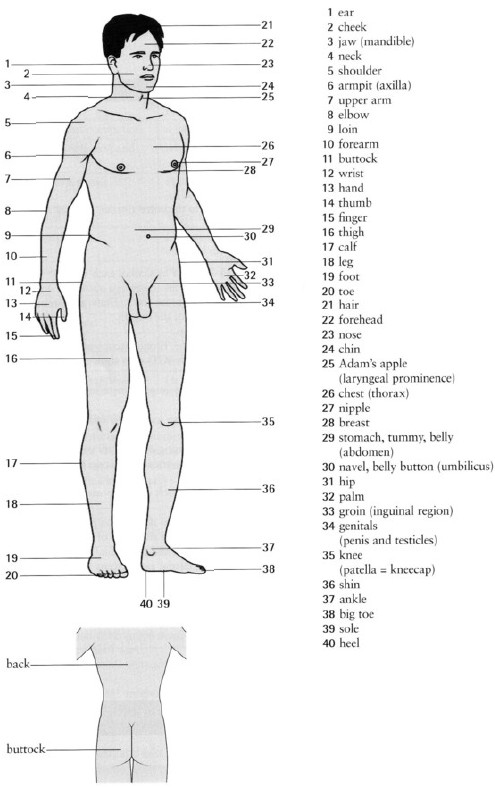Anglický jazyk
1.3 Medical English
We can divide the human body in several parts:
- the head,
- the neck,
- the trunk,
- the limbs = extremities.
The head consists of the skull = cranium which protects the brain, and the face. In the face we can distinguish the forehead, two eyebrows, two eyes with eyelids and eyelashes, the nose with two nostrils, the mouth with two lips, the tongue and teeth, the cheeks, and the chin which is formed by the mandible = jaw. Ears and earlobes are on the sides of the head. The upper and back sides of the head are covered by the scalp with hair. The parts of the head behind the forehead are called temples. The top of the head is the crown, and the part under it is the back of the head.
The head is connected with the trunk by the neck. The inside of the neck is called the throat. Men sometimes have a protruding Adam's apple at the front.
The trunk is divided in the chest = thorax or thoracic cavity in the upper part and the abdomen (tummy, belly) in the lower. The back is on the other side. The chest is formed by ribs which are connected by the sternum = breastbone. This creates the ribcage which protects the lungs and the heart, and other tissues. On the chest there are breasts and nipples.
Under the chest and on the side part of the trunk there is the waist and the hip under it.
The abdomen contains other organs such as the stomach, the duodenum, the liver, the gallbladder, the pancreas, the spleen, the kidneys, the bladder, the small and large intestines = bowels, and the inner reproductive organs. On the abdomen there is the navel = bellybutton and the external reproductive organs = genitals in the groins. On the bottom part of the back there are the loins and the buttocks under them.
The upper limbs or extremities are arms and they are formed by the shoulder, the upper arm, the elbow which is an articulation = joint, the forearm, the wrist and the hand, which consists of the palm and the back of the hand, and five fingers = digits. The finger opposite the others is called the thumb. The first finger is called index finger = first finger, then the middle finger, the ring finger, and finally the small finger = pinkie, pinky. The joints in the fingers are called knuckles. At the tip of the fingers are nails. Under the shoulder on the inner part of the chest there is the armpit = axilla.
The lower limbs are legs joined with the pelvis and constituted by the hip, the thigh, the knee with the kneecap = patella, the lower leg with the shin in front and the calf in the back, the ankle and the foot. The foot consists of the dorsum = instep, the sole, the arch, the heel with the Achilles tendon, and five toes.
The osseous = bony framework that enables people to stand upright is the backbone = spine = vertebral column which contains the spinal cord. The whole body is covered with skin which protects the soft tissues under it. There might be freckles on the skin and scars from injuries or operations.
|
skull [skal]
|
lebka
|
|
forehead
|
čelo
|
|
eyebrow
|
obočí
|
|
eyelid
|
oční víčko
|
|
nostril
|
nosní dírka
|
|
cheek
|
tvář
|
|
chin
|
brada
|
|
earlobe
|
ušní boltec
|
|
temple
|
spánek
|
|
crown
|
temeno
|
|
rib
|
žebro
|
|
cavity
|
dutina
|
|
tissue
|
tkáň
|
|
nipple
|
bradavka
|
|
waist
|
pas
|
|
hip
|
bok
|
|
gallbladder
|
žlučník
|
|
spleen
|
slezina
|
|
bladder
|
měchýř
|
|
loins
|
bedra
|
|
groins
|
slabiny, třísla
|
|
forearm
|
předloktí
|
|
armpit
|
podpaždí
|
|
pelvis
|
pánev
|
|
instep
|
nárt
|
|
sole
|
chodidlo
|
|
arch [arč]
|
klenba
|
|
freckle
|
piha
|
|
scar
|
jizva
|
|
Some adjectives derived from Latin
|
|
|
abdominal
|
břišní
|
|
cervical
|
krční
|
|
dental
|
zubní
|
|
frontal
|
čelní
|
|
gastric
|
žaludeční
|
|
hepatic
|
jaterní
|
|
inguinal
|
tříselný
|
|
intestinal
|
střevní
|
|
lingual
|
jazykový
|
|
mandibular
|
čelistní
|
|
oral
|
ústní
|
|
osseous
|
kostěný, kostní
|
|
pelvic
|
pánevní
|
|
renal
|
ledvinový
|
|
spinal [spainl]
|
míšní
|
|
umbilical
|
pupeční
|
|
urinary
|
močový
|
|
vascular
|
cévní
|
|
vertebral
|
páteřní
|
Be careful about irregular nouns:
1 tooth – 2 teeth, 1 foot – 2 feet!
Parts of the human body
Source: Glendinning a Howard, 2007, s. 130
